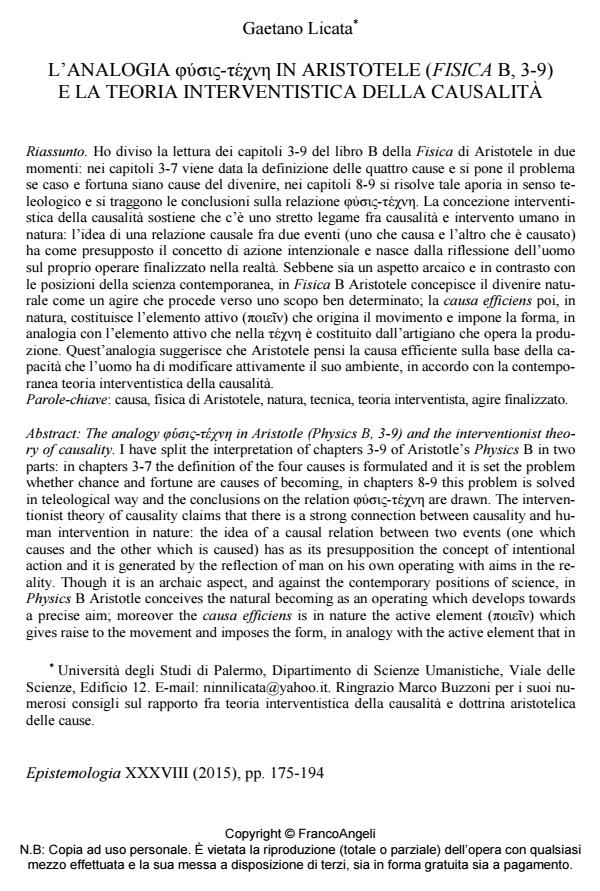"The nature of art" in Aristotle (Physics B, 3-9) and the interventionist theory of causality.
Journal title EPISTEMOLOGIA
Author/s Gaetano Licata
Publishing Year 2016 Issue 2015/2 Language Italian
Pages 20 P. 175-194 File size 217 KB
DOI 10.3280/EPIS2015-002001
DOI is like a bar code for intellectual property: to have more infomation
click here
Below, you can see the article first page
If you want to buy this article in PDF format, you can do it, following the instructions to buy download credits

FrancoAngeli is member of Publishers International Linking Association, Inc (PILA), a not-for-profit association which run the CrossRef service enabling links to and from online scholarly content.
I have split the interpretation of chapters 3-9 of Aristotle’s Physics B in two parts: in chapters 3-7 the definition of the four causes is formulated and it is set the problem whether chance and fortune are causes of becoming, in chapters 8-9 this problem is solved in teleological way and the conclusions on the relation φύσις-τέχνη are drawn. The interventionist theory of causality claims that there is a strong connection between causality and human intervention in nature: the idea of a causal relation between two events (one which causes and the other which is caused) has as its presupposition the concept of intentional action and it is generated by the reflection of man on his own operating with aims in the reality. Though it is an archaic aspect, and against the contemporary positions of science, in Physics B Aristotle conceives the natural becoming as an operating which develops towards a precise aim; moreover the causa efficiens is in nature the active element (ποιεῖν) which gives raise to the movement and imposes the form, in analogy with the active element that in τέχνη is the craftsman who operates the production. This analogy suggests that Aristotle conceives the efficient cause on the basis of the human ability to modify the environment, in agreement with the contemporary interventionist theory of causality.
Keywords: Cause, Aristotle’s physics, nature, technique, interventionist theory, aimed operating
- Aristotele, Fisica, ed. it. a cura di L. Ruggiu, Milano, Rusconi, 1995.
- Aristotele, Metafisica, ed. it. a cura di G. Reale, Milano, Rusconi, 1993.
- Aristotele, Etica Nicomachea, ed. it. a cura di C. Mazzarelli, Milano, Rusconi, 1996.
- Berti E. (1989-1990). La finalità in Aristotele, Fondamenti, 14-16, pp. 8-44.
- Buzzoni M. (2004). Esperimento ed esperimento mentale, Milano, FrancoAngeli.
- Buzzoni M. (2014). The Agency Theory of Causality, Anthropomorfism and Simultaneity, International Studies in the Philosophy of Science, 28(4), pp. 375-395.
- Buzzoni M. (2015). Teleology and Mechanism in Biology. In Bertolaso M. (ed.), The Future of Scientific Practice: “Bio-Techno-Logos”, London, Pickering & Chatto, pp. 147-159.
- Bywater I. (1894). Aristotelis Ethica Nicomachea, Oxford, Clarendon Press.
- Cardullo R.L. (2005). L’analogia τέχνη/φύσις e il finalismo universale in Aristotele, PHYS. II. In Cardullo R.L., Giardina G.R. (eds.), La Fisica di Aristotele oggi. Problemi e prospettive, Catania, CUECM, pp. 51-109.
- Collingwood R.G. (1940). An Essay on Metaphysics, Oxford, Clarendon Press.
- Dingler H. (1938). Die Methode der Physik, München, Reinhardt.
- Hacking I. (1983). Representing and Intervening: Introductory Topics in the Philosophy of Natural Science, Cambridge, Cambridge University Press.
- Heidegger M. (1953). Die Frage nach der Technik. In Vorträge und Aufsätze, Pfullingen, Verlag Günther Neske (trad. it. La questione della tecnica, in Vattimo G. (ed.), Saggi e discorsi, Milano, Mursia, 1976, pp. 5-27).
- Heidegger M. (1959a). Brief über den «Humanismus». In Wegmarken 1919-1958, Gesamtausgabe Bd. 9, Frankfurt am Main, Vittorio Klostermann (trad. it. Lettera sull’«uma nismo», in Volpi F. (ed.), Segnavia, Milano, Adelphi, 1987, pp. 267-315).
- Heidegger M. (1959b). Vom Wesen und Begriff der φύσις. Aristoteles, Physik, B, 1. In Wegmarken 1919-1958, Gesamtausgabe Bd. 9, Frankfurt am Main, Vittorio Klostermann (trad. it. Sull’essenza e sul concetto della φύσις. Aristotele, Fisica, B, 1, in Volpi F. (ed.), Segnavia, Milano, Adelphi, 1987, pp. 193-255).
- Maturana H.R., Varela F.J. (1980). Autopoiesis and Cognition. The realization of the Living, Dordrecht, Reidel.
- Natali C. (1989). La saggezza di Aristotele, Napoli, Bibliopolis.
- Nicolaci G. (1999). Metafisica e metafora. Interpretazioni aristoteliche, Palermo, L’Epos.
- Ross W.D. (1936). Aristotle’s Physics, Oxford, Clarendon Press.
- Ross W.D. (1924). Aristotle’s Metaphysics (2 voll.), Oxford, Clarendon Press.
- Scharle M. (2008). Elemental Teleology in Aristotle’s Physics 2. 8, Oxford Studies in Ancient Philosphy, 34, pp. 147-184.
- Von Wright G.H. (1971). Explanation and Understanding, Ithaca (NY), Cornell University Press.
- Von Wright G.H. (1989). A Reply to My Critics. In Schilpp P.A., Hahn L.E. (eds.), The Philosophy of Georg Henrik Von Wright, La Salle (Ill.), Open Court, pp. 733-887.
- Zeller E., Mondolfo R. (1974). La filosofia dei greci nel suo sviluppo storico, Firenze, La Nuova Italia.
- Aristotle’s Doctrine of Causes and the Manipulative Theory of Causality Gaetano Licata, in Axiomathes /2019 pp.653
DOI: 10.1007/s10516-018-9398-y
Gaetano Licata, L’analogia "La natura dell’Arte" in Aristotele (Fisica B, 3-9) e la Teoria Interventistica della Causalita in "EPISTEMOLOGIA" 2/2015, pp 175-194, DOI: 10.3280/EPIS2015-002001